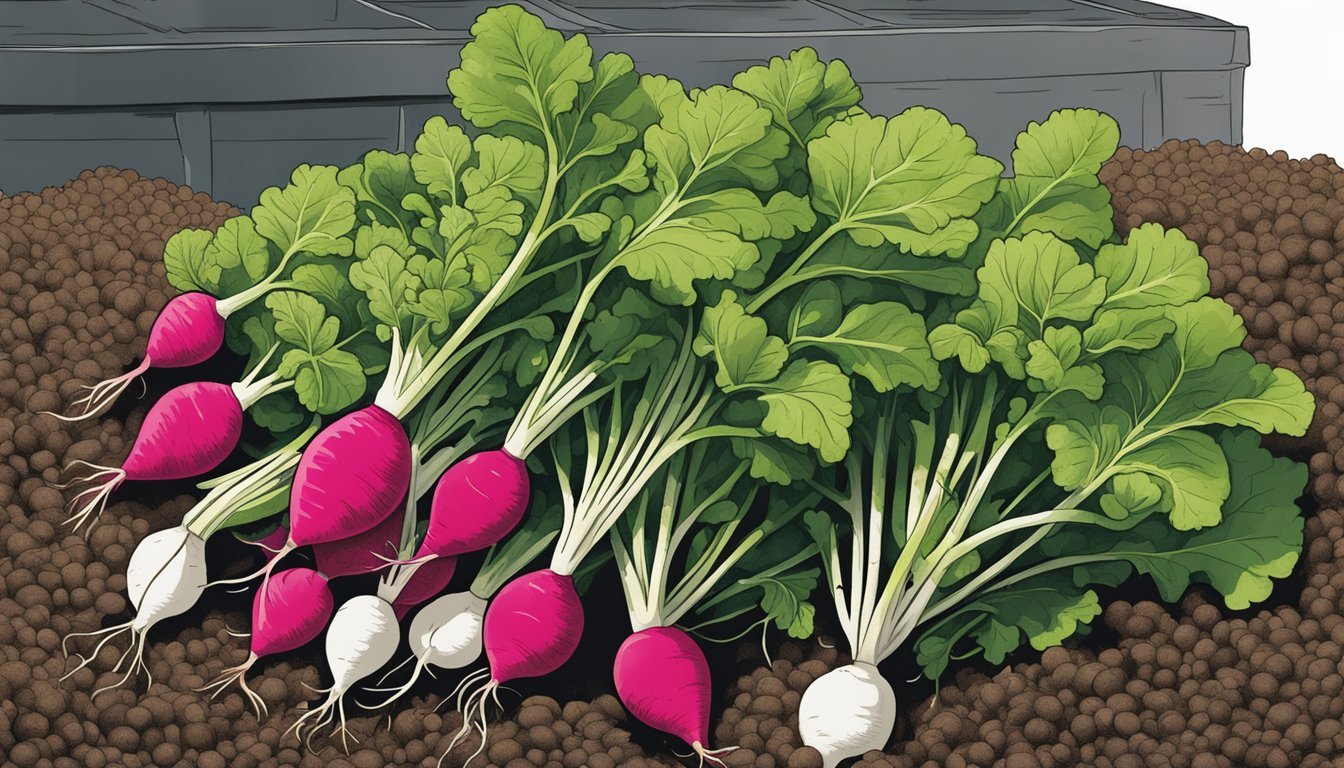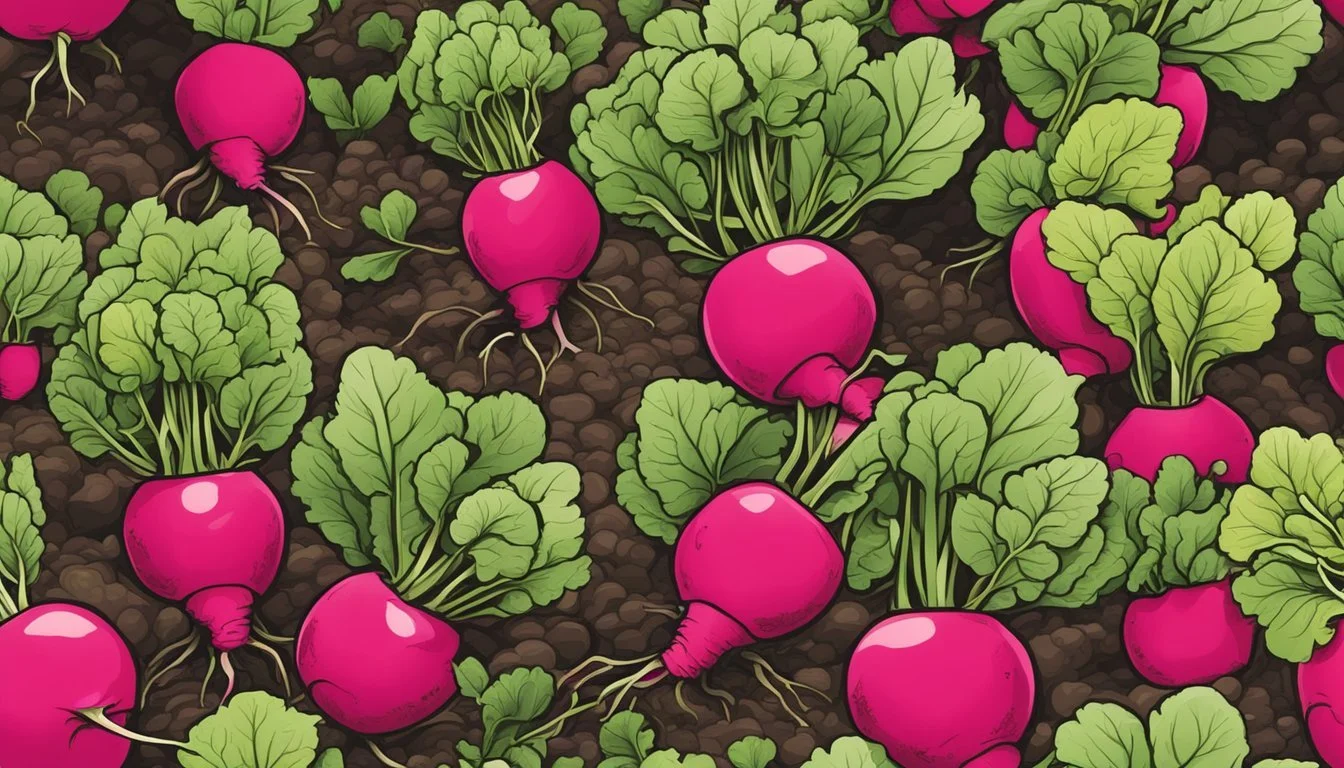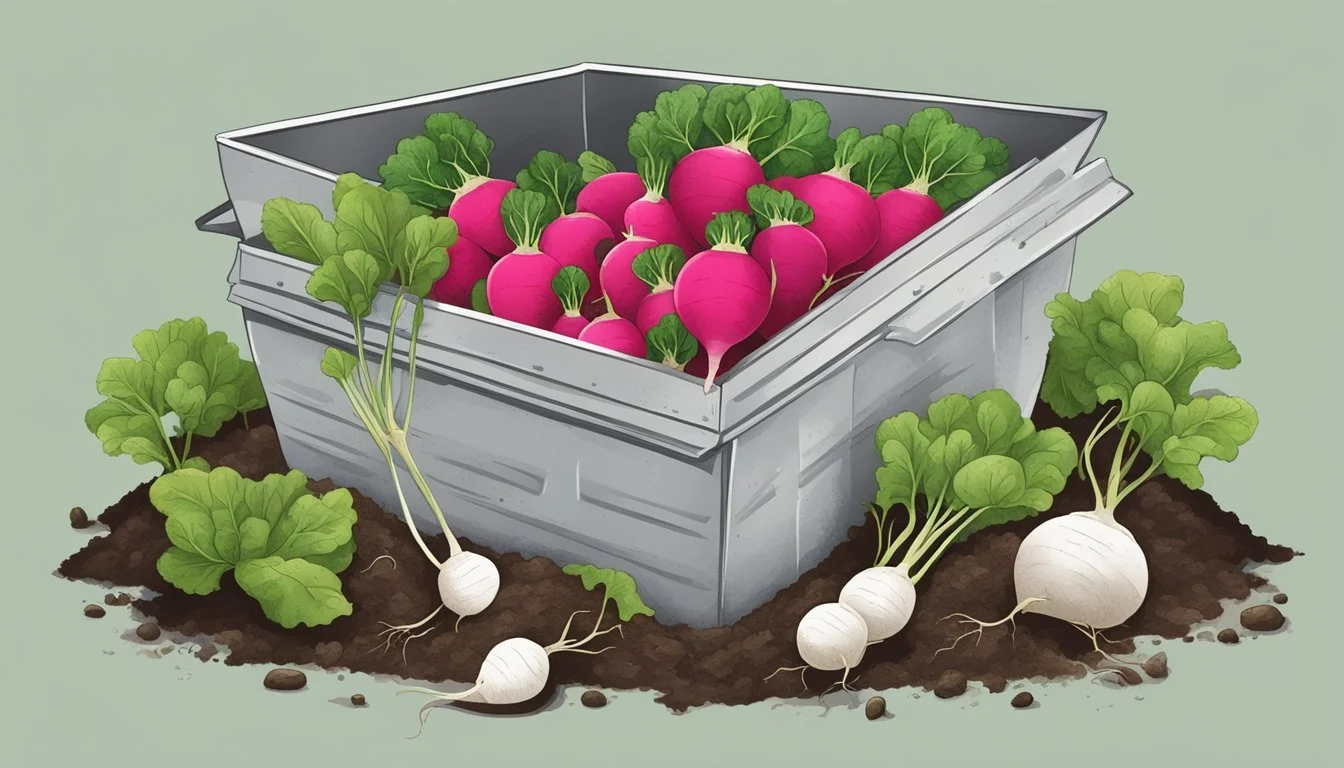Can You Compost Radish Tops?
The Definitive Guide to Recycling Green Waste
Gardeners often seek sustainable ways to manage their vegetable scraps, and one question that commonly arises is whether radish tops can be incorporated into a compost pile. Radish tops, like most vegetable greens, are a valuable source of organic matter that can be composted effectively. These leafy greens count as 'green' compost material, which is rich in nitrogen, an essential component that aids in the decomposition of 'brown' materials such as dry leaves and twigs in the composting process.
In the world of composting, organic matter is categorized into 'green' and 'brown' materials, each playing a significant role in creating a balanced compost pile. Green materials provide nitrogen, while brown materials supply carbon. This balance is crucial to support the microorganisms that break down the waste, turning it into nutrient-rich compost that is beneficial for gardening. By adding radish tops to a compost pile, gardeners can contribute to this balance, as the radish greens will decompose readily, enhancing the overall composting process and ultimately enriching the soil.
Overview of Radish Tops
Radish tops, the leafy green part of the radish plant, are often overlooked in favor of their brightly colored root counterpart. However, they are not only edible but also nutritious. Rich in vitamin C and calcium, radish greens can be a healthy addition to a salad or cooked dish. They have a peppery flavor, similar to arugula, and can add a zesty twist to meals.
The greens are most often consumed fresh, and their texture can range from tender to slightly coarse, depending on the maturity of the leaves. When incorporating radish tops into dishes, they can be used as:
Raw: Added to salads for a fresh, crisp texture.
Cooked: Sautéed or braised as a side dish.
Garnish: Chopped finely to garnish soups or tacos.
In terms of their role in composting, radish tops are considered a 'green' compost material. This means they are rich in nitrogen, which is necessary for the decomposition process in a compost pile. Here's a brief breakdown of their compost attributes:
Composition Benefit in Compost High in nitrogen Accelerates decomposition of 'browns' Organic material Enhances overall compost health
It is advisable to chop radish greens into smaller pieces before adding them to the compost heap, as this will help them decompose more efficiently. While radishes can make a valuable addition to compost, balancing them with carbon-rich 'brown' materials is key to a successful composting process.
Benefits of Composting Radish Tops
Composting radish tops provides multiple advantages to a garden's ecosystem. They are a source of organic matter that, when decomposed, enhances soil structure and fertility. As "green" materials, radish tops are rich in nitrogen, an essential component that acts in tandem with carbon-rich "brown" materials, such as dried leaves, to create a balanced compost.
Nutrient Cycling: Radish tops contribute to the nutrient cycle within compost by breaking down to release nitrogen. This nutrient is vital for plant growth and helps to build the protein content in the soil’s microbial life. The presence of these nutrients, once returned to the soil, facilitates the development of robust, healthy plants.
Moisture Retention: When added to compost, the moisture content in radish leaves aids in maintaining adequate moisture levels. This is crucial as moisture is needed to sustain the microbial activity that drives the composting process.
Enhanced Soil Health: As radish tops decompose, they become organic matter that improves soil aeration and water retention. This indirectly stimulates root growth and fosters an environment conducive to beneficial microorganisms.
Sustainability: By composting radish tops, gardeners reduce waste and return valuable nutrients to the earth. This practice exemplifies a sustainable approach, turning what might have been discarded into a resource that can perpetuate a cycle of growth and soil enrichment.
Incorporating radish tops into compost not only recycles these greens but also capitalizes on their inherent properties to create a more healthful and fruitful garden space.
Composting Basics
To successfully compost, an individual needs a basic understanding of the composting process, what a compost bin requires, and how to balance the greens and browns—nitrogen and carbon-rich materials.
Understanding Composting Processes
Composting is the controlled decomposition of organic matter by microorganisms into a nutrient-rich soil amendment. Microorganisms such as bacteria and fungi play a critical role, breaking down materials into humus—the beneficial soil-like substance that enhances soil health. For effective decomposition, maintaining the right temperature and moisture levels is essential, as these factors influence the activity of the microorganisms. A well-managed compost pile will reach temperatures between 135-160°F, killing off most weed seeds and pathogens.
Compost Bin Requirements
A designated compost bin provides a controlled environment for composting. It can range from a simple pile to a complex worm bin system, but it should always facilitate proper air circulation and moisture management. Here are the components typically required for a proper bin:
Vents or holes for airflow
A lid or cover to retain heat and moisture
An access point to turn the pile, promoting oxygen flow
Materials like wood or plastic to contain the pile
Including a diverse mix of organic matter such as vegetable scraps, fruit peels (excluding lemon peels which take longer to decompose), eggshells, and stale bread, encourages a more complete and balanced decomposition.
Balancing Nitrogen and Carbon
Nitrogen (green materials) and carbon (brown materials) must be balanced for optimal composting conditions. Nitrogen provides the protein source needed for microorganisms to grow and multiply, while carbon acts as an energy source.
Green materials: include kitchen scraps, grass clippings, and yes, radish tops.
Brown materials: involve dried leaves, straw, and woody branches.
Here is a simplified ratio guideline:
Green (Nitrogen-rich) Materials Brown (Carbon-rich) Materials 1 part 3 parts
Maintaining the correct ratio accelerates the composting process while minimizing odor and deterring pests.
Preparing Radish Tops for Composting
Composting radish tops effectively contributes to a nutrient-rich compost pile. These leafy greens are a source of nitrogen, which is a crucial component for the successful decomposition of compost material. To prepare radish tops for composting, one should first ensure they are free from disease and pest infestation to prevent spreading issues to the compost.
Steps to Prepare Radish Tops:
Harvesting: Separate the radish tops from the roots after the harvesting of radishes. Ensure the leaves are fresh; wilted or older tops may take longer to decompose.
Chopping: Cut the radish tops into smaller pieces. Smaller pieces decompose faster as they provide more surface area for the microbes and worms to work on.
Here’s a simplified table for material preparation:
Material Action Purpose Radish Tops Chop Speed up decomposition Compost Balance Mix with Browns Ensure proper C ratio
It is important to balance these nitrogen-rich greens with 'brown' compost material, such as dry leaves or shredded paper, to maintain an optimal carbon to nitrogen (C) ratio. An imbalance in the compost pile can lead to an unpleasant odor or slow down the decomposition process.
Adding radish tops to the worm bin is also beneficial, as they are an excellent food source for worms. Worms enhance the composting process by breaking down organic material and producing vermicompost, which is rich in nutrients and beneficial for plant growth.
In sum, incorporating radish tops into a compost pile bolsters its nitrogen content and aids in creating a balanced ecosystem for quicker decomposition of organic waste.
Common Composting Challenges
Composting organic materials like radish tops can enhance soil fertility and encourage healthy plant growth. However, some challenges may arise, including pest management, composting diseases, and the need to avoid toxic substances.
Pest Management
In the composting process, pests such as flea beetles and cabbage maggots can be attracted to the organic matter. Flea beetles are known to attack radish leaves, potentially migrating to the compost pile. To mitigate this, composters should:
Ensure a proper balance of green and brown materials to increase decomposition speed.
Use a compost bin with a closed lid to deter pests.
Regularly turn the compost to disrupt the life cycle of insects.
Composting Diseases
Plant diseases can spread through compost if infected materials are added to the pile. For example, fungal diseases can persist in the compost and later infect the garden soil. Composters can avoid this by:
Excluding diseased plant material from the compost.
Maintaining high temperatures in the compost pile to kill pathogens.
Turning the compost pile frequently to facilitate even decomposition and pathogen removal.
Avoiding Toxic Substances
Certain natural substances can be toxic to plants. Juglone, found in walnut trees, and oils present in eucalyptus leaves, are harmful to many plants. Composters should:
Avoid adding walnut leaves, twigs, or hulls to the compost.
Refrain from composting eucalyptus leaves or ensure they are well-aged and diluted in a large compost batch.
By addressing these challenges, composters can produce quality compost, avoid introducing harmful elements to the garden, and sustain a thriving ecosystem within their soil.
Radish Varieties and Compost Compatibility
In the context of composting, it is essential to consider that not all radish varieties contribute to compost in the same way. Their nutrient content and rate of decomposition can vary, which affects their suitability for composting.
Common Radish Varieties
French Breakfast: A mildly spicy, elongated radish with a white tip.
Daikon: A large, mild-flavored white radish often used in Asian cuisine.
Cherry Belle: A small, round, bright red radish that is crisp and has a classic radish bite.
Each radish variety has a distinct texture and size, which directly relates to how they break down in a compost pile. All parts of the radish plant, including the tops, can be added to compost.
Determining Compost Suitability
Radish Tops:
Radish leaves, commonly known as tops, are high in nitrogen.
Recommended to chop into smaller pieces for faster breakdown.
Nutrient Content:
Radishes are considered 'green' materials, rich in nutrients that assist in the composting process.
Determining Factor for Suitability:
Growth Rate: Rapid growth makes radishes excellent for composting since they decompose quickly.
Garden Impact: The inclusion of radish tops in compost contributes to a nutrient-rich garden environment.
When assessing compost suitability, consider both the type of radish and its growth stage. For instance, tougher, mature radish tops may take longer to compost than young, tender ones.
Composting and Radish Cultivation
The integration of composting in radish cultivation enriches soil and optimizes growth conditions, enhancing the overall health and yield of the garden.
Soil Enrichment with Compost
Composting introduces organic matter into the garden soil, which decomposes to provide a range of essential nutrients that are vital for the healthy growth of radishes. Compost acts both as a fertilizer and a soil conditioner, contributing to creating rich soil that supports radish development. The decomposed organic matter from radishes, including their tops, becomes a nutrient-rich amendment, bolstering the soil structure and fertility.
Benefits of Composting in Soil Impact on Radish Growth Increases soil nutrient content Promotes healthier radish plants Enhances soil water retention Ensures consistent moisture supply Improves soil aeration Encourages robust root development Balances soil pH Supports nutrient uptake efficiency
Optimal Growth Conditions for Radishes
For radishes to thrive, they require well-drained soil, consistent watering, and a sunny location. The soil temperature is crucial, with radishes favoring conditions that are neither too cold nor excessively warm. Proper spacing is important; radishes need enough room to develop. Proper composting is beneficial in regulating soil temperature and moisture levels, making the garden bed more conducive to growing radishes. When transitioning from compost to planting:
Radishes should be sown in soil that has warmed to at least 40°F (4°C).
They must receive full sun to partial shade for optimal growth.
Adequate spacing, about 2 inches apart, is necessary to avoid overcrowding.
Regular watering, ensuring the soil remains moist but not waterlogged, is key for even root development.
Additional Ways to Use Radish Tops
Radish tops are often discarded, yet they offer a variety of uses in the kitchen and carry substantial health benefits. These leafy greens can elevate meals with their peppery flavor and enhance one's diet with their nutritional content.
Incorporating Radish Tops in Meals
Radish tops can be a versatile ingredient in the kitchen. Salads benefit from the leaves' peppery taste, providing a refreshing twist. They can be used fresh or sautéed and added to egg dishes or as a vibrant garnish. Transforming radish tops into pesto is another innovative use, offering a unique flavor in place of traditional basil. To incorporate them into warm dishes, consider adding these greens into soups or stews for a peppery kick, or wilt them into a comforting pasta dish for added texture. When used as a component in a sandwich, they lend a crisp, spicy element.
Health Benefits of Radish Tops
Radish leaves are not only edible but they are highly nutritious. They are a good source of vitamin C, which supports immune function, and antioxidants that may protect cells from damage. The greens are rich in iron and potassium, which are essential for maintaining healthy blood pressure levels and overall cardiovascular health. Incorporating radish tops into one's diet can contribute to nutritional diversity and support overall health and well-being.
Environmental Impact of Composting
Composting, the process of breaking down organic matter such as food waste and garden debris, has significant positive effects on the environment. When organic waste is composted, it is prevented from ending up in landfills. This reduction in landfill contributions is crucial because decomposing waste in landfills produces methane, a potent greenhouse gas.
Benefits to Soil and Plant Health:
Nutrient-Rich Soil: Compost adds essential nutrients back into the soil, enhancing soil fertility.
Water Retention: Improved soil structure from composting aids in water conservation.
Reduction in Chemical Use:
The use of compost can decrease the reliance on chemical fertilizers in gardening. Natural compost fosters a rich, balanced ecosystem that supports plant growth.
Enhancing Biodiversity:
Composting supports the proliferation of beneficial organisms such as earthworms. These organisms play a vital role in soil health and nutrient cycling. Their activities produce worm castings, which are highly valued for their nutrient content.
Environmental Benefits List:
Reduces methane emissions from landfills
Decreases the volume of waste in landfills
Limits the need for synthetic fertilizers
Enhances soil quality and biodiversity
Promotes the growth of earthworms and the production of worm castings
In essence, composting transforms waste into a resource that benefits the environment by improving soil health, thus closing the loop in the organic waste cycle. Through this environmentally-friendly practice, gardening can contribute to an overall healthier planet.
Conclusion
Radish tops are not only edible but also highly beneficial for composting. In gardening practices, these green leafy parts of radishes contribute essential nitrogen to compost piles. They act as "green" materials, which pair well with "brown" materials like dry leaves or twigs. When radish tops are added to a pile, they enhance the nutrient content, thereby promoting soil health and structure upon decomposition.
Gardeners who practice sustainability can significantly benefit from composting radish tops. By recycling these greens, they contribute to a reduction in organic waste and support the creation of a more nutrient-rich environment for their gardens. Composting, a natural and eco-friendly process, ties into sustainability goals by returning valuable organic matter back into the soil, creating a closed-loop system in gardening efforts.
To optimize the process, gardeners may consider balancing the compost pile with an adequate mix of green and brown materials, ensuring proper aeration, and maintaining appropriate moisture levels. This encourages efficient breakdown and results in quality compost that can be used to improve the fertility of the soil, ultimately leading to healthier plant growth and a more productive garden.
Thus, composting radish tops stands as a testament to effective waste management and soil health promotion, aligning perfectly with the core principles of sustainable gardening.









